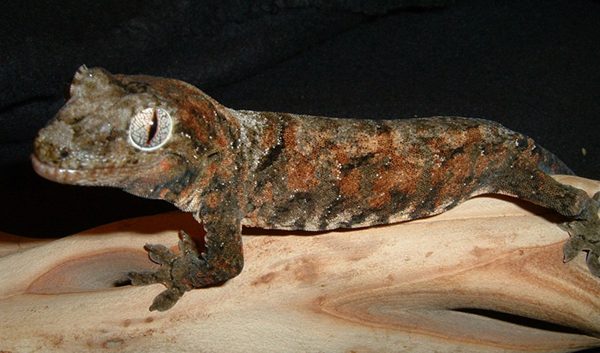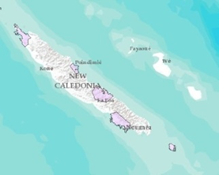New Caledonian Mossy Prehensile-tailed Gecko
New Caledonian Mossy Prehensile-tailed Gecko (Chahoua)
Rhacodactylus chahoua

Printable Care Sheet
Explore More!

General Information
Family: Gekkonidae
Locale: New Caledonia, Grande Terre and Isle of Pines
Habitat: Arboreal; found in moist rainforest areas
Average Size: SVL 5.7”; TL ~10”
Average Lifespan: 20-30 years
Activity: Nocturnal
Care Summary
Captive Care: Minimum 20 gal high aquarium; enclosures taller than they are wide is preferred with a screen lid for maximum circulation. All screen enclosures sold for chameleons also work well. Plants with thin branches for climbing; avoid plants with sharp, protruding twigs. Substrate can be paper towel, but a more naturalistic soil/peat mix or unmilled sphagnum moss may be preferred (keep naturalistic substrate moist but not wet). Need shallow water dish.
Temperature: Thrive in temperatures ranging from 70-85°F, but never more than 85°F (prefer 72-78° F). Heat may be provided over one end of tank with incandescent light, but temperature should be monitored so it doesn’t become too hot.
Lighting: No special lighting required. If the terrarium is located near a window, natural light could be sufficient, but never place tank in direct sun. Fluorescent light (UV-B) will benefit the plants and may benefit the gecko.
Diet: Omnivorous—commercially available food preferred. Commercial diets including Pangea Fruit Mix Complete, and Repashy Crested Gecko diet. Insects such as crickets, mealworms, flies should also be offered at least occasionally. Require calcium/D3 supplementation in their diet, and should be dusted on insects. If commercial diet is not available, baby food (fruit flavored): apples, peaches, pears, apricots, any flavor aside from citrus fruits may be used. If using primarily baby food, mix 9 parts fruit, 1 part meat (turkey or chicken), and calcium/D3 supplement. Feed small amounts relative to their size either daily or every other day (plastic water bottle lids make good dishes for the baby food mixture). Adjust amount offered based on quantity consumed.
Breeding: Reach maturity between 14 and 18 months, 2 eggs in a clutch, 3 clutches per year at 60 day intervals. Female does not bury eggs. Egg shells very thick and rigid. Only 1/3-1/2 of eggs successfully hatch. Males have hemipenal bulges and enlarged cloacal spurs, can see preanal pores at 3” SVL.
Temperament: Timid, can be handled for brief periods. Likes to jump. Hand-to-hand movement.
Notes: Do not appear to exhibit TSD. Can be kept in breeding groups of 1 male and 3-4 females. Never house more than one male per enclosure. Rarely loses tail, but will not regenerate tail if lost. Keeping females separate from males will prevent fertile egg production.
References
Bartlett, P.P., Griswold, B., Bartlett, R.D. (2001). Reptiles, Amphibians, and Invertebrates, an identification and care guide. Barron’s Educational Series, Hauppauge, NY. 279pp.
DeVosjoli, P., Fast, F., Repashy, A. (2003). Rhacodactylus: The complete guide to their selection and care. Advanced Visions, Inc. Vista, CA. pp145-239.
Henkel, F.W., Schmidt, W. (1995). Geckos, Biology, Husbandry, and Reproduction. Kreiger Publishing company, Malabar, Florida. 237pp.
Seipp, R., Henkel, F. 2000. Rhacodactylus, Biology, Natural History & Husbandry. Chimaira Buchhandelsgesellschaft mbH. Frankfurt am Main. 173 pp.
Photo: Eileen Underwood
Range Map: Shannon Magers
Compiled by Eileen Underwood. Updated 8/2016.
Related Projects
by students in the BGSU Herpetarium
The Herpetarium is a facility in the Department of Biological Sciences.
Bowling Green State University | Bowling Green, OH 43403-0001 | Contact BGSU Herpetarium | Campus Map
Updated: 04/13/2021 12:30PM


